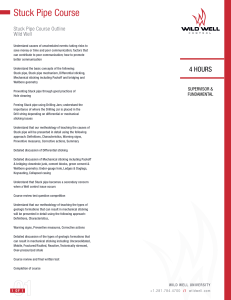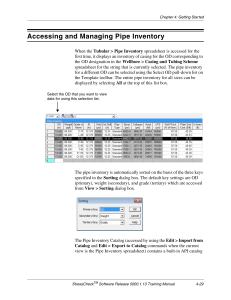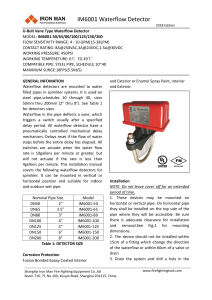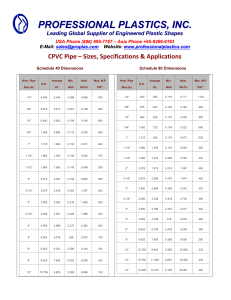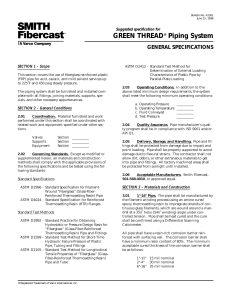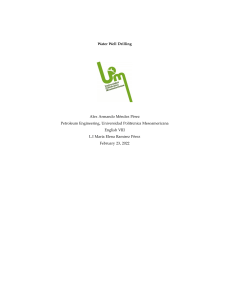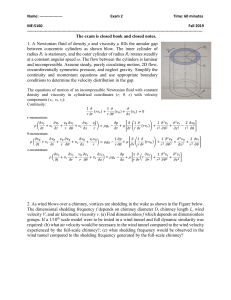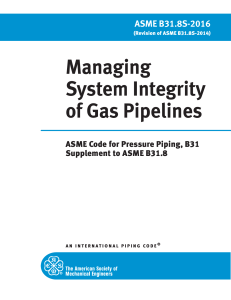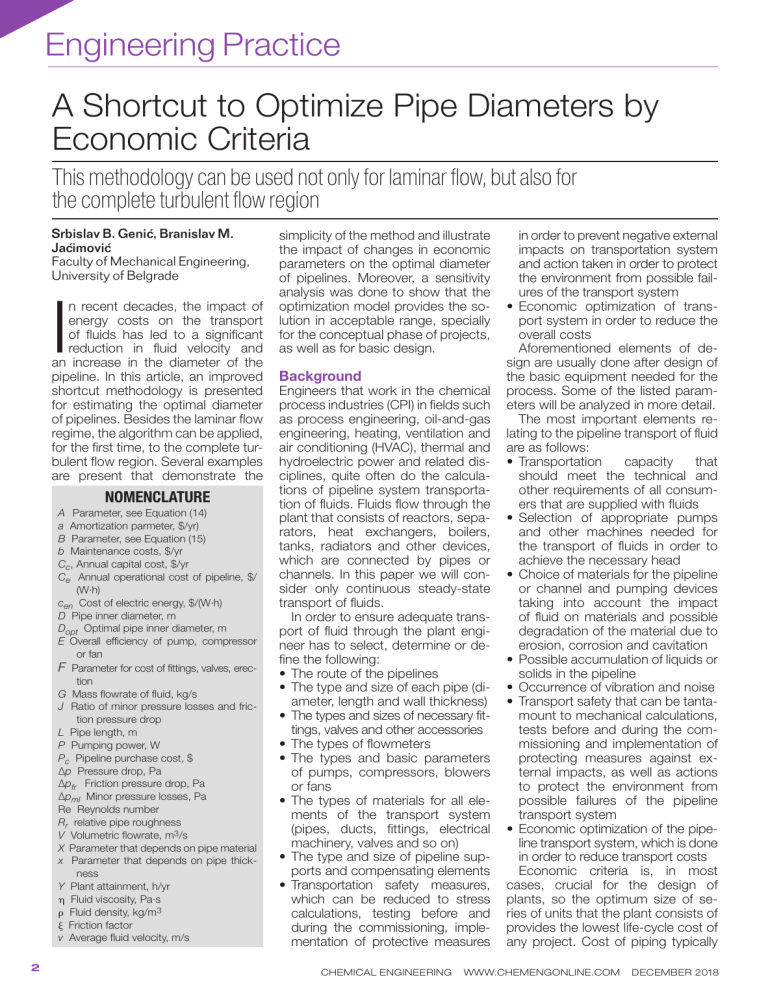
Engineering Practice A Shortcut to Optimize Pipe Diameters by Economic Criteria This methodology can be used not only for laminar flow, but also for the complete turbulent flow region Srbislav B. Genić, Branislav M. Jaćimović Faculty of Mechanical Engineering, University of Belgrade I n recent decades, the impact of energy costs on the transport of fluids has led to a significant reduction in fluid velocity and an increase in the diameter of the pipeline. In this article, an improved shortcut methodology is presented for estimating the optimal diameter of pipelines. Besides the laminar flow regime, the algorithm can be applied, for the first time, to the complete turbulent flow region. Several examples are present that demonstrate the NOMENCLATURE A Parameter, see Equation (14) a Amortization parmeter, $/yr) B Parameter, see Equation (15) b Maintenance costs, $/yr Cc, Annual capital cost, $/yr Ce Annual operational cost of pipeline, $/ (W·h) cen Cost of electric energy, $/(W·h) D Pipe inner diameter, m Dopt Optimal pipe inner diameter, m E Overall efficiency of pump, compressor or fan F Parameter for cost of fittings, valves, erection G Mass flowrate of fluid, kg/s J Ratio of minor pressure losses and friction pressure drop L Pipe length, m P Pumping power, W Pc Pipeline purchase cost, $ Δp Pressure drop, Pa Δpfr Friction pressure drop, Pa Δpml Minor pressure losses, Pa Re Reynolds number Rr relative pipe roughness V Volumetric flowrate, m3/s X Parameter that depends on pipe material x Parameter that depends on pipe thickness Y Plant attainment, h/yr η Fluid viscosity, Pa·s ρ Fluid density, kg/m3 ξ Friction factor v Average fluid velocity, m/s 2 simplicity of the method and illustrate the impact of changes in economic parameters on the optimal diameter of pipelines. Moreover, a sensitivity analysis was done to show that the optimization model provides the solution in acceptable range, specially for the conceptual phase of projects, as well as for basic design. Background Engineers that work in the chemical process industries (CPI) in fields such as process engineering, oil-and-gas engineering, heating, ventilation and air conditioning (HVAC), thermal and hydroelectric power and related disciplines, quite often do the calculations of pipeline system transportation of fluids. Fluids flow through the plant that consists of reactors, separators, heat exchangers, boilers, tanks, radiators and other devices, which are connected by pipes or channels. In this paper we will consider only continuous steady-state transport of fluids. In order to ensure adequate transport of fluid through the plant engineer has to select, determine or define the following: • The route of the pipelines • The type and size of each pipe (diameter, length and wall thickness) • The types and sizes of necessary fittings, valves and other accessories • The types of flowmeters • The types and basic parameters of pumps, compressors, blowers or fans • The types of materials for all elements of the transport system (pipes, ducts, fittings, electrical machinery, valves and so on) • The type and size of pipeline supports and compensating elements • Transportation safety measures, which can be reduced to stress calculations, testing before and during the commissioning, implementation of protective measures CHEMICAL ENGINEERING in order to prevent negative external impacts on transportation system and action taken in order to protect the environment from possible failures of the transport system • Economic optimization of transport system in order to reduce the overall costs Aforementioned elements of design are usually done after design of the basic equipment needed for the process. Some of the listed parameters will be analyzed in more detail. The most important elements relating to the pipeline transport of fluid are as follows: • Transportation capacity that should meet the technical and other requirements of all consumers that are supplied with fluids • Selection of appropriate pumps and other machines needed for the transport of fluids in order to achieve the necessary head • Choice of materials for the pipeline or channel and pumping devices taking into account the impact of fluid on materials and possible degradation of the material due to erosion, corrosion and cavitation • Possible accumulation of liquids or solids in the pipeline • Occurrence of vibration and noise • Transport safety that can be tantamount to mechanical calculations, tests before and during the commissioning and implementation of protecting measures against external impacts, as well as actions to protect the environment from possible failures of the pipeline transport system • Economic optimization of the pipeline transport system, which is done in order to reduce transport costs Economic criteria is, in most cases, crucial for the design of plants, so the optimum size of series of units that the plant consists of provides the lowest life-cycle cost of any project. Cost of piping typically WWW.CHEMENGONLINE.COM DECEMBER 2018 represents up to 35% of plant capital cost [1]. Fluid pumping cost is also an important part of plant operation cost. According to the U.S. Dept. of Energy (DOE), 16% of a typical facility’s electricity costs are involved with pumping of fluids [2]. It is therefore useful to design the piping system as close as possible to the optimal value, in order to obtain minimal sum of capital and operating charges. Mathematically rigorous methods for selecting pipe diameters are time-consuming because they involve detailed (iterative) procedures to determine the minimum capital and operating costs. Simple equations, like the one proposed in this article, can provide reasonably accurate estimates of optimal pipe diameters in the initial stages of a plant design, which are a good starting point for a more rigorous procedure. The first pipe economic optimization model was published in 1937 for turbulent flow in hydraulically smooth pipes [3] and three years later the model was broadened for laminar flow [4]. These models are widely cited in literature and they even became classic university lectures [5]. Recently, a new model was published for hydraulically rough pipes [6]. This article contains new and simple models for economic pipe size for laminar, turbulent and transitional flow. Pipe optimization model Pipeline cost consists of two parameters: capital cost and operational cost. The most economic pipe diameter will be the one which gives the lowest annual cost. Pipe purchase cost can be expressed as Equation (1): (1) Where: D = pipe I.D., m L = pipe length, m X = a parameter that depends on the type of pipe material x = a parameter that depends on the pipe-wall thickness (pipe schedule) The annual capital cost (Cc, $/yr) of pipeline is calculated using Equation (2): (2) CHEMICAL ENGINEERING Where: F = a factor that includes the cost of valves, fittings and erection a = amortization or capital charge (annual) b = maintenance costs (annual) The power required for fluid pumping (P, W) is given by Equation (3): plies only to incompressible isothermal flow. In engineering practice, this equation can be accepted for the compressible flow if the total pressure drop is less than 10% of the initial pressure [8]. The annual operational cost of pipeline (Ce, $/yr) is: (3) (9) Where: V, = volumetric flowrate of fluid, m3/s ρ = fluid density, kg/m3 Δp = pressure drop, Pa E = overall efficiency of pump, compressor or ventilator G = mass flowrate of fluid, kg/s (4) Energy loss in pipeline includes fluid friction loss, but also potential and kinetic energy losses. This model excludes the latter two losses since the pumping height is always a fixed value and fluid density is considered to be constant. This means that the pressure drop can be calculated as the sum of friction pressure drop (Δpfr, Pa) and minor pressure losses (Δpml, Pa) (5) Weisbach [7] proposed in 1845 the equation that is still in use for pressure drop calculations: which yields: (10) Where: Y, = the plant attainment (annual operating hours or hours of operation per year), h/yr cen, = cost of pumping energy, $/W·h Total annual pipe cost is (11) and, since C depends only on D, the optimum economic pipe diameter can be found by (12) After differentiation of capital, Equation (2), and operational costs Equation (10), the general form of the solution of Equation (12) is: (6) Where: ξ = friction factor coefficient v, = average fluid velocity, m/s Minor pressure losses can be estimated either as head losses or by using equivalent lengths. In further analysis, the minor pressure losses will simply be taken into account as (7) (13) Parameter A consists of values that must be presupposed for every single pipeline (14) and parameter B shows the influence of pipe diameter on friction factor: (15) (8) In order to obtain the useful shortcut formula for estimation of Dopt, the derivative dξ/dD has to be determined for laminar, critical and turbulent flow. The pipe friction factor, in general, depends on the Reynolds number: Strictly speaking, Equation (8) ap- (16) where J is the ratio of minor pressure losses and friction pressure drop. Pressure drop then becomes: WWW.CHEMENGONLINE.COM DECEMBER 2018 3 TABLE 1 PRICES OF ELECTRICITY AND CARBON-STEEL PIPES and relative pipe roughness (17) The friction factor for all cases of flow regimes in pipes can be calculated using [9] (18a) Parameter cen, $/(kW•h) x X J Value 0.08 1.5 330 0.5 Parameter F a+b Y , h/yr E TABLE 2 CALCULATIONS ACCORDING TO THE “RULES OF THUMB” AND PROPOSED MODEL Literature Recommended D, mm v, m/s Re Rr ξ [11] 285 2.742 1,077,000 0.00351 0.0269 [12] 279 2.871 1,102,000 0.00359 0.0270 [13] 289 2.658 1,061,000 0.00345 0.0267 New model 341 1.915 900,000 0.00293 0.0255 Δp/L, Pa/m 422 75.3 477 72.8 389 77.1 164 98.6 103.5 178.8 116.8 189.6 95.3 172.4 40.1 138.7 Cc/L, $/(yr•m) (18b) Ce/L, $/(yr•m) C/L, $/(yr•m) Economic flowrate or velocity Optimal pipe diameter equations can be rewritten in order to estimate the most economic flowrate or velocity for a given pipe diameter. From Equa(18c) tion (13), the optimal mass flowrate is: Pipe relative roughness, according to open literature data, is in the range Rr = 0 to 0.0333. For laminar flow explicit solution is B = 3.24, and for other flow regimes the mean value of B should be estimated after integration. For critical flow: (19) and for turbulent flow (after setting of the upper limit of the integral to Re = 108 which is a value that is of importance to engineering practice) (21) the optimal volumetric flowrate is: (22) and the optimal fluid velocity is (23) Algorithm for solving equations Equation (13) provide implicit calculation procedure since the pipe diameter has to be known in order to obtain the friction factor or vice versa. Solving of Equation (21), (22) or (23) also demand the iterative procedure since ξ is a function of fluid velocity. The easiest way for solving the listed equations is to make the (20) assumption of a fluid velocity or friction factor and then apply an iterative Our estimation for variables that procedure. In case of turbulent flow, should be known for calculation of no more than three iterations are A are presented in Table 1, and the needed. For laminar flow, no more final value is A = 0.00236. than five iterations are needed. After applying A in Equation (13), one can get (A.B)1/5+x = 0.47 for Example 1 laminar flow and (A.B)1/5+x = 0.49 The authors were recently asked for other flow regimes. Therefore, a to estimate the optimal diameter value of (A.B)1/5+x = 0.48 is adopted of carbon steel pipeline for liquid for all flow regimes in all of the sub- methanol at ambient temperature. sequent calculations. Methanol flowrate was 500 ton/h, its density is 794 kg/m3 and viscosity 4 Value 6.5 0.2 8,760 0.6 CHEMICAL ENGINEERING is 0.000576 Pa·s. We adopted the absolute roughness ε = 1 mm as a guess value for the end of pipeline life cycle of 10 years. Solution. Using the methodology proposed above yields an optimal pipe diameter of Dopt = 341 mm, the corresponding velocity is v = 1.915 m/s and pressure drop is Δp/L = 164 Pa/m. This corresponds to the total pipe cost of C/L = 138.7 $/(yr·m). Rules of thumb from various literature sources give the results presented in Table 2. The value calculated by Equation (13) gives the velocity that is significantly lesser than the ones from the cited recommendations. The consequential total pipeline cost is about 30% greater than the one calculated by hereby proposed model. This fact is in good agreement with conclusion from Ref. 10 about the influence of energy cost on pipe diameter in last decades. Example 2 For the next example, consider the flow of bitumin through a carbonsteel pipeline with D = 82.5 mm, with volumetric flowrate of V = 20 m3/h. At 150°C, the density of bitumen is ρ = 959 kg/m3 and the viscosity is η = 0.407 Pa·s. What is the optimal pipe diameter and what savings can be obtained after replacing the existing pipeline with the optimal one if the length of pipeline is L = 1,000 m? Solution. According to Equation (13), the optimal pipe diameter is Dopt = 110 mm (v = 0.585 m/s, Re = 152, ξ = 0.422) and pressure drop is Δp = 9.44 bars. For further analysis we have used the standard steel pipe DN100 (O.D. WWW.CHEMENGONLINE.COM DECEMBER 2018 TABLE 3 SENSITIVITY ANALYSIS OF PARAMETERS Parameter Production rate Fuel/energy cost Capital investment Range of Variation ±20% –50% to +100% –20% to +50% = 114.3 mm, I.D. = 107.1 mm). Using Equations (2) and (10), capital cost is Cc = 17,350 $/yr, operational costs are Ce = $6,820/yr, so the total cost is C = $24,170/yr. For D = 82.5 mm, the pipeline total cost is C = $31,090/yr. This means that, after replacement, each year the savings will be $6,920, and the investment will be paid off after 4.5 yr. On the other hand, recommended velocities and pressure drops from the literature are: 0.6–1.0 m/s in Ref. 14, 0.9–1.2 m/s and 450 Pa/m in Ref. 13, 0.2–1 m/s in Ref. 15, 0.9–1.5 m/s in Ref. 16 for viscous oils and pipelines with nominal diameter DN80–DN250. It is obvious that these recommendations are not covering the region of laminar flow and following them one can make serious mistake. Sensitivity analysis The economic analysis consists of the following two parts: 1. The investment and cash flows are first calculated using with the most probable values of the various factors (this establishes the base case for analysis). 2. Various parameters in the cost model are then varied, assuming a range of error for each factor in turn, in order to provide how sensitive the cash flows and economic criteria are to errors in the forecast figures. In other words, the basic economic analysis of a project is based on the best estimates that can be made at the moment of design of the system, and a sensitivity analysis is a way of examining the effects of uncertainties in the forecasts on the viability of a project. The purpose of sensitivity analysis is to identify those parameters that have a significant impact on project viability over the expected range of variation of the parameter. Range of variation of typical parameters are given in Table 3, which is adopted from Ref. 17. Data from Table 3 means the following variation of parameters: CHEMICAL ENGINEERING TABLE 4 PIPELINE DIAMETER FOR EXAMPLE 1 AFTER SENSITIVITY ANALYSIS Parameter Dopt, mm G = 160–240 t/h 309–370 310 –341 ε = 0.05–1 mm a + b = 0.1–0.2 E = 0.6–0.85 J = 0–2 cen = 0.04–0.16 $/(kW•h) A = 0.8–1.5 of basic A Mean value 341–382 327–341 320–382 307–382 300–402 316–371 • G should be in range 0.8 to 1.2 of basic G • cen should be in range 0.5 to 2 of basic cen • A should be in range 0.8 to 1.5 of basic A Furthermore, for the shortcut model presented here, we should include the following: • The factor of minor losses in range J = 0 to 2 • Pump efficiency from E = 0.6 up to E = 0.85 • a + b in range 0.1–0.20 • Rr should be taken into account for new also as for old pipes — for carbon steel pipes ε = 0.05–1 mm Let’s reconsider Example 1. After consideration of the sensitivity analysis, we get the pipe diameters listed in Table 4. In this case, the mean value of the pipeline diameter is in range Dopt = 316–371 mm, which is a variation of less than ±10% of the pipe diameter of Dopt = 341 mm obtained in Example 1. Following the data from Table 4, for this example, one can conclude that the variation of pipe diameter is not significant due to the (very strong) exponent 5 + x = 6.5 in Equation (13). Concluding remarks The simple optimization model of pipe diameter presented here is suitable for both laminar and turbulent flow. The sensitivity analysis shows that the optimization model can provide the solution in acceptable range that is especially suitable for the conceptual phase of projects, as well as for the basic design. n Edited by Gerald Ondrey References 1. Capps, R. W., Select the Optimum Pipe Size — Simple Equations can Quickly Optimize Pipe Diameters, Chem. Eng., vol. 105., no. 7., pp. 165–166, 1995. 2. “Improving Pumping System Performance: A Sourcebook for Industry,” Hydraulic Institute ITP, 2006. WWW.CHEMENGONLINE.COM DECEMBER 2018 3. Genereaux, R. P., Fluid-Flow Design Methods, Ind. Eng. Chem., vol. 29, pp. 385–388, 1937. 4. Sarchet, B. R., and Colburn, A. P., Economic Pipe Size In The Transportation Of Viscous And Nonviscous Fluids, Ind. Eng. Chem., vol. 32, pp. 1,249–1,252, 1940. 5. Sinnott, R. K., “Chemical Engineering Design,” Butterworth-Heinemann, 1996. 6. Genic´, S., Jac´imovic´, B., Genic´, V., Economic Optimization of Pipe Diameter for Complete Turbulence, Energy and Buildings, vol. 45, pp. 335–338, 2012. 7. Weisbach, J., “Lehrbuch der Ingenieur- und MaschinenMechanik,” Braunschwieg, 1845. 8. Peters, M. S., Timmerhaus, K. D., “Plant Design and Economics for Chemical Engineer,” McGraw Hill, New York, N.Y., 1991. 9. Genic´, S., Jac´imovic´, B., Reconsideration of the Friction Factor Data and Equations for Smooth, Rough and Transition Pipe Flow, Lecture held in Engineering Chamber of Serbia, Belgrade, April 2016. 10. Durand, A. A., and others, Updating the Rules For Pipe Sizing, Chem. Eng., vol. 116, no. 1, pp. 48–50, 2010. 11. Adams, J. N., Quickly Estimate Pipe Sizing with ‘Jack’s Cube,” Chem. Eng. Progress, vol. 93, no. 12, pp. 55– 59, 1997. 12. “Piping Engineering,” Tube Turns Inc., Louisville, 1986. 13. Walas, S. M., “Chemical Process Equipment – Selection and Design,” Butterworth-Heinemann, Boston, Mass., 1990. 14. Coker, A. K., “Ludwig’s Applied Process Design for Chemical and Petrochemical Plants“, Fourth Edition: Volume 1, Elsevier Inc., 2007. 15. Pavlov, K. F., Romankov, P. G., Noskov, A. A., “Chemical Technology Processes and Equipment: Examples and Tasks,” Leningrad, Nedra Publ., 1987. 16. Datta, A., “Process Engineering And Design Using Visual Basic,” CRC Press, 2008. 17. Genic´, S., Jac´imovi, B., Mitic´, S., Kolendic´, P., “Economic Analysis for Process Engineering” (in Serbian), Association of Mechanical and Electrical Engineers and Technicians of Serbia, Belgrade, 2014. Authors Srbislav Genić is full professor of “Heat transfer operations and equipment,” “Mass transfer operations and equipment” and “Economic analysis in process engineering” at the Dept. of Process Engineering of the Faculty of Mechanical Engineering of the University of Belgrade (Kraljice Marije 16, 11120 Belgrade 35; Phone: +381-11-3302-200; Email: ). His research interests include heat and mass transfer processes and equipment. He holds B.Sc., M.Sc., and Ph.D. degrees in mechanical engineering from the University of Belgrade. He is a court expert and registered Professional Engineer in Serbia. Branislav Jaćimović is retired full professor of “Heat transfer operations and equipment” and “Mass transfer operations and equipment” at the Dept.of Process Engineering of the Faculty of Mechanical Engineering of the University of Belgrade. He is a registered Professional Engineer in Serbia and holds B.Sc., M.Sc., and Ph.D. degrees in mechanical engineering at University of Belgrade. He has over 35 years experience in the field of separation processes (especially distillation) and heat exchangers design. 5

